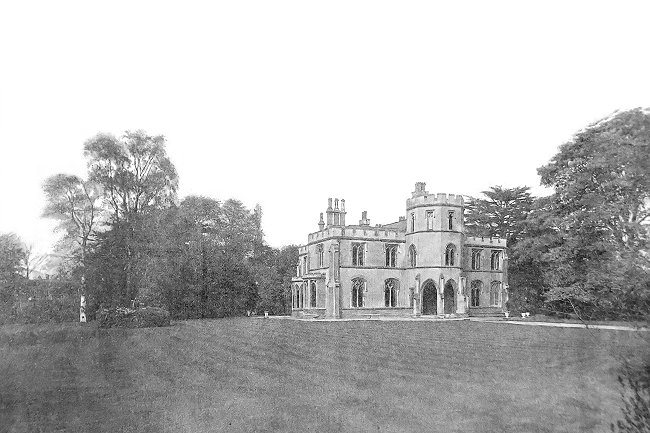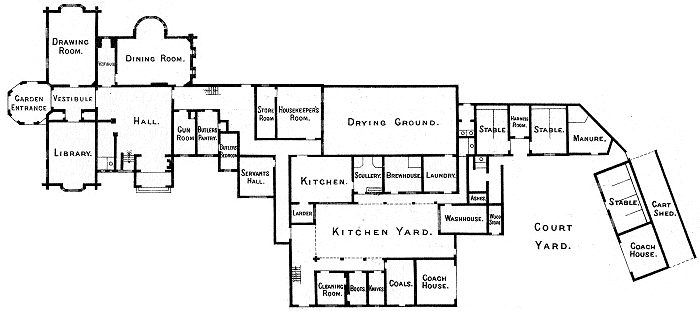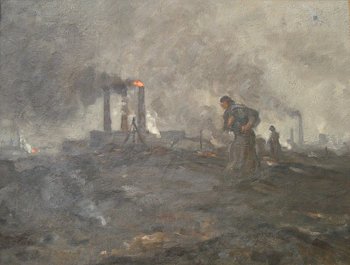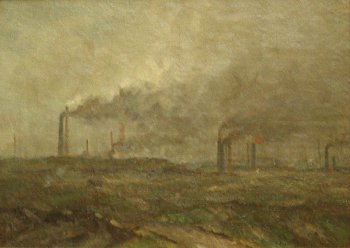Edwin was born in 1874 into a wealthy family. He grew-up at 7 Merridale Road, Wolverhampton and had a privileged childhood. He was the eldest of Samuel and Emma Bayliss’s eight children. His father, a successful and prominent local businessman became chairman of the family’s manufacturing company, Bayliss, Jones and Bayliss. Within a few years the family moved to one of Tettenhall’s grandest houses, ‘The Woodhouse’ in Wood Road. The family had several members of staff, including a ladies companion, a nurse, a cook, and three maids. At the age of fourteen Edwin was sent to the Rydal Mount School in Colwyn Bay, a Methodist school, where he stayed for four years.
At the age of eighteen he returned home and became a prolific artist, working in a large studio built for him in the grounds of the family home. On his return he joined his father in the family business, and worked there for several years, but his only interest, other than golf, was painting, and so he left the business and became a full-time artist. He saw, and became fascinated with the harsh conditions in the Black Country, a landscape dotted with factories, ironworks, coal mines, slag heaps, pit mounds, and canals. He had no formal training in art, but taught himself how to draw, and work in watercolours, oils, and pastels. He successfully captured the stark, smoky atmosphere of the Black Country, particularly the impressive ironworks, and the red glows and black smoke that emanated from them. Luckily Sir Alfred Hickman, owner of Bilston steelworks, was a family friend and so Edwin could wander around the works at will. In 1907 at the age of thirty three he married Elizabeth, a parson’s daughter. They moved into ‘The Beeches’ in Regis Road, Tettenhall, where they lived for over twenty years. They had two sons and a daughter, and many artists including George Phoenix, Bernard Fleetwood Walker, and Victor Deville visited him there. In 1901 he displayed paintings with the Wolverhampton Art Circle, and in 1904 had paintings in the spring and autumn exhibitions of the Birmingham Society of Artists. Between 1899 and 1928 he exhibited paintings in the annual exhibitions at The Royal Academy of Art. Edwin became a member of the Royal Birmingham Society of Artists, vice president of the Wolverhampton Society of Artists, president of the Birmingham Easel Club, and a member of several local societies. Although he was also a successful rural landscape painter, he will always be remembered for his depictions of the industrial Black Country. Several of his paintings feature the large ironworks at Darlaston, and other general industrial landscapes show scenes at Tipton and Bilston. In the late 1930s Edwin and his family moved to a house in Woodthorne Road where they stayed until the early 1940s when the house was requisitioned for use by the Ministry of Agriculture and Fisheries. They then rented a house called ‘Greenhills’. Edwin died in 1950 and will always be remembered for his marvellous industrial scenes which bring the old Black Country back to life. A number of his works are in the Wolverhampton Art Gallery. They are not on permanent display but have been brought out from time to time. In July 2005 they achieved some fame when they appeared, in the Art Gallery's storage racks, in a BBC TV programme presented by Richard Dimbleby. This lead to some of the works being temporarily hung on the staircase. In recent years there has been at least one small exhibition at the art gallery featuring some of the paintings. Occasionally one or two of Edwin's paintings can be seen on display. The pictures which follow are all in the possession of the Wolverhampton Art Gallery. The images may not be reproduced in any form or media without the written permission of the Wolverhampton City Council. All of the pictures are oils. The colour reproduction cannot, of course, be guaranteed.
Thanks must go to Wolverhampton City Council for permission to show the pictures. As always, any further information about the artist and his work would be gratefully received. |






